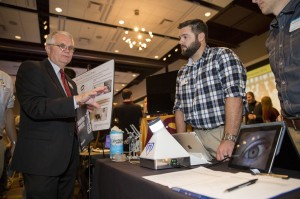
Innovation Showcase celebrates student innovation

Paul Johnson, dean of the Ira A. Fulton Schools of Engineering, checks out one of the student projects at Innovation Showcase. Electrical systems and robotics students Matt Dickens, Samantha Janko, Lynne Nethken and Praveen Sinha worked on the development of a sign language glove, a robotic-guided wearable device that could serve as an educational tool to teach American Sign Language. Photographer: Jessica Hochreiter/ASU
From an eye-imaging system for Mayo Clinic, to a device that could improve railroad-crossing safety, to a robotic-guided glove to help teach sign language, students in Arizona State University’s Ira A. Fulton Schools of Engineering are creating technologies to solve real-world problems.
This fall’s Innovation Showcase at ASU’s Polytechnic campus highlighted the work of student teams that created innovative and imaginative solutions to meet a variety of challenges.
“It’s not just the solutions that impress us, but also the process in which students work directly with faculty mentors and industry leaders who partner with our students for new ideas,” said Paul Johnson, dean of the Ira A. Fulton Schools of Engineering. “This collaboration is enriching for both sides and provides an introduction to industry for our students. The relationships that develop are rewarding and often result in job offers.”

Connor Pyle, senior mechanical engineering technology student, explains his team’s project to visitors. The mobile crossing device they worked on is capable of turning any rail car into a warning system. The flashing light, activated when a train approaches a crossing, could help prevent 1,200 deaths each year on rural roads. It uses wind and solar power as part of its sustainable design. Photographer: Jessica Hochreiter/ASU
The Innovation Showcase was organized into “neighborhoods” inspired by innovators through the ages. Including high school projects, senior-year capstone design projects, eProjects, and undergraduate and graduate student projects, the showcase highlighted the process of invention and creation.
One of the outstanding undertakings was the Mayo Clinic Telemedicine eProject, which brought together mechanical engineering technology and manufacturing engineering technology students Joseph Blaylock, Brandon Bosworth, David Cadis, Lance Cardey and Stephen Ginos, working under the mentorship of Jerry Gintz, senior lecturer in the Polytechnic School.
The scope of their project was to research and evaluate existing commercially available components that could be integrated into an iOS-based camera system.
“The goal was to create a proof-of-concept device that allows technical professionals to capture exterior images of a patient’s eye and transfer them to a specialist for diagnosis,” said Bowsworth, a senior from Mesa. “We see this technology being used in situations like on cruise ships, where there are large numbers of people in places where accessing an eye doctor could be challenging.”

Stephen Ginos, senior manufacturing engineering student, talks to a visitor at the Innovation Showcase about the team’s Mayo Clinic Telemedicine eProject. The goal was to create a proof-of-concept device that allows technical professionals to capture anterior images of a patient’s eye and transfer them to a specialist for diagnosis. Photographer: Jessica Hochreiter/ASU
The team’s device is a 3D-printed prototype that enables a person to look closely through a lens that takes a picture and transfers it to an iPad for transfer to a medical specialist for diagnosis.
According to Lindsay Clark, senior analyst and program manager for Mayo Clinic, what the students created was “beyond words,” in that it was developed “in time, on scope and in budget,” with consideration for both patient and care team.
“We had the software and concept developed, and wanted to work with ASU engineering to create the hardware and integrate the pieces,” Clark said. “It was good to have the extra energy and creativity the students brought from the outside. Very impressive.”
Media Contact:
Sharon Keeler, [email protected]
(480) 727-5618
Ira A. Fulton Schools of Engineering



































